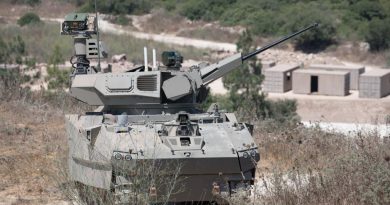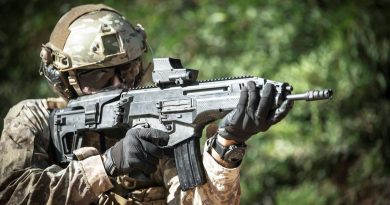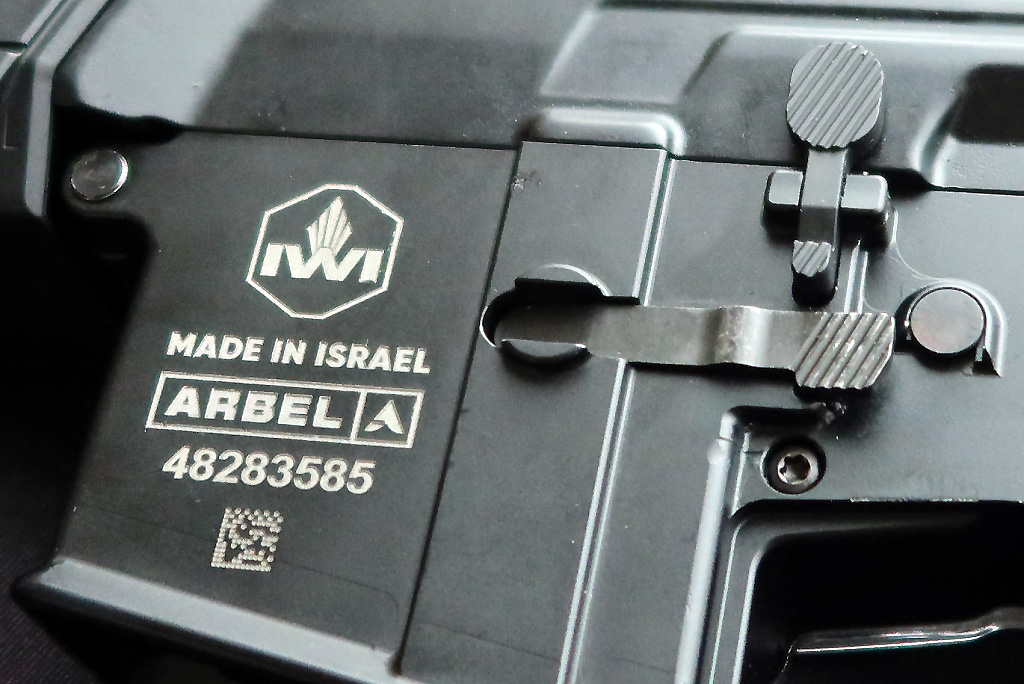
Increasing accuracy, reducing ammo consumption: IWI Arbel computerised system
Israel Weapons Industry, IWI in short, part of the SK Group, developed a computerised system, the Arbel, which considerably increases shooting accuracy both for AR15-based assault rifles as well as for light machine guns
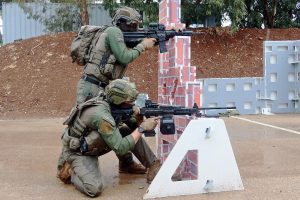
“In 1969 the man landed on the moon, however the rifle remained more or less the same for over 90 years. Ten years ago, we started to work with our research and development team to change that,” Samy Katsav, the Chairman of the SK Group explained adding, “Now we have the solution,” Israel IWI unveiling the Arbel computerised system that allows to dramatically increase light machine guns (LMGs) and assault rifles accuracy, with minimal impact on training.
“The indications were clear, we should develop a system that brings no change to the weapon handling, and which can be used to upgrade existing weapons,” the SK Group Chairman added, as on one hand armies do not want to be confronted with training issues, while many services are not ready to change their small arms inventory. And this is what the Arbel is capable to do, increasing lethality by over 100%, according to the company, while having practically zero impact on training and maintenance skills.
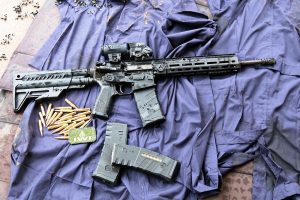
“Around five years ago we came up with the decision to focus on AR15 platforms,” a company representative stated. He emphasised the work done on electro-mechanisms, as well as on algorithms that work on a very sophisticated CPU, which among other ensure very reduced latency, a key feature when time is at stake. EDR On-Line understood that the work started on the Carmel, then on the Tavor X95, and finally on the Arad and the Negev.
The Arbel was designed with the aim of improving accuracy, which has various effects, one being that of reducing ammunition consumption. Lethality is definitely the raison d’être of an infantryman, and ammunition is what allows him to deliver lethal power, however it is also a burden; in many armies the standard rifleman load is seven magazines, one in the weapon and six in the combat vest, which means around 3.2 kg if we talk of a 5.56×45 mm assault rifle or 3.5 kg if we consider a 7.62×51 mm weapon. Overall ammunition mass increases when considering belt fed machine guns, which have a much greater ammo load, usually 100 rounds at ready plus spares. Better aiming brings higher effectiveness and reduced ammo consumption, increasing the number of possible engagements with the same number of rounds (reducing the ammo quantity is another option, although less likely). It also allows delivering a considerable number of hits in a reduced time. Accuracy also brings beneficial effects on cost, that of the single round in the operational theatre being much higher than the actual production cost, as we must consider the whole logistic chain that brings it in the hands of the deployed soldier, and associated risks.
To reduce ammo consumption and improve soldiers’ effectiveness, the best solution is thus to ensure that a maximum percentage of fired rounds reaches the intended target.
Arbel Negev
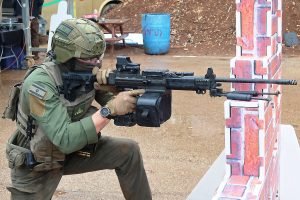
Although IWI integrated firstly the Arbel on an assault rifle, we consider that where the system will definitely revolutionise things is in the LMGs world, as when fitted with the new system these will be able to provide aimed sustained fire rather than suppressive fire, which might well bring also to a revision of TTPs. Looking at LMGs, for the time being IWI applied the Arbel to its Negev machine gun both in 5.56 and 7.62 mm calibres. EDR On-Line could witness shooting results obtained by company instructors under stress and fatigue, without and with the Arbel system; with the standard machine gun in full auto, firing short bursts, three-four out of 10 rounds hit the target at 50 metres, while using the Arbel all 10 were inside it. Shooting in automatic mode at 85 metres distance, the maximum allowed by the firing range of the Ginegar kibbutz, located in northern Israel, not far from Nazaret, the results were respectively of three and nine rounds on target out of 10. In a video shown during a presentation, as said the facility where the new system presentation took place was limited in range, nine out of 10 rounds hit the 2.2×2.2 metres target in slightly more than 3 seconds at 500 metres distance, compared to only two in a slightly shorter time without the Arbel.
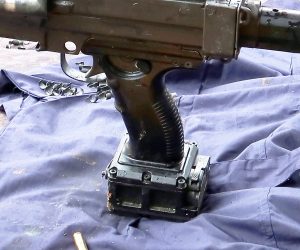
Where is the Arbel system located and how does it work? IWI makes it clear that all man-machine interfaces remain the same of the standard Negev, therefore no specific training is needed. The only difference is that the selector position originally used for the semi-automatic mode has now become the Arbel position, the selector having thus now the Safe, Arbel and Auto positions. The core of the system is installed in the weapon’s grip; this includes the trigger assembly and mechanic elements, while all the electronics and the battery are located in a pod under the grip, the main visible feature that distinguishes the Negev/Arbel compared to the standard weapon. The whole ensemble adds around 900 grams, battery included, to the weapon’s mass (the equivalent of 30 7.62 mm or 52 5.56 mm linked rounds), that of a standard 5.56 mm Negev with an 18-inch (440 mm) barrel being 7.6 kg while the mass of the Negev NG-7 in 7.62 mm calibre with a 20-inch (508 mm) barrel is 7.95 kg, both without magazine and bipod. Being in the grip, the extra mass does not affect the balance. The Li-Ion battery is rechargeable, the energy being sufficient to power the electronics for 60 hours of constant use, the system being activated only when the operator puts the selector lever in the Arbel position. Energy consumption is therefore limited; “We did tests with some western armies and the battery was recharged just once in six to eight months,” Tal Dvir, IWI VP Marketing and Sales Europe told EDR On-Line. The battery can be recharged using a 110-220 V AC charger or in alternative a 12-28 V DC charger, but it can also be replaced at field level, battery status and low battery indicators being fitted in the system.
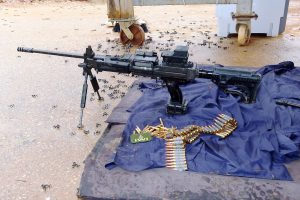
Stress and fatigue, coupled to short windows of opportunities, typical of fast-moving targets, make machine gun supporting fire inaccurate and ineffective, some people even stating that “most of the time machine gun fire makes holes in the air.” Stress and fatigue induce several physical issues, including reduced concentration, slower response, accelerated breathing, increased heart rate, trembling and impaired motor functions, all affecting accuracy. In the aforementioned tests with some undisclosed armies, four operators were asked to shoot in semi-auto mode with a standard Negev without Arbel, and in auto mode with an Arbel-augmented Negev. Prior to the run each operator performed five burpees before dropping to the prone shooting position, scanning a sector. Four pop-up targets were located in the sector at different distances, 100, 150, 175 and 200 metres, and were made visible just once, for an average time of 3 seconds.
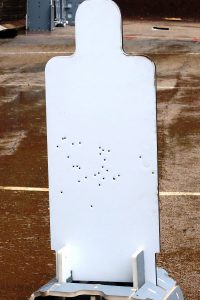
Against moving target EDR On-Line could witness a 90% hit result from a Negev mounted on a tripod, shooting at a human size board mounted on a robotized platform moving from left to right at a credible speed, at 50 metres distance. We were allowed to test personally the Arbel; shooting from the prone position against human-size targets at 85 metres range with a Negev 5.56 mm LMG fitted with a Meprolight M5 electro-optical red dot sight, after an initial familiarisation, results were comparable to those mentioned earlier, with a four-fold improvement between the all-auto mode and the Arbel mode.
Arbel-equipped weapons were used against unmanned aerial systems (UAS), here too improving results. EDR On-Line could not witness those tests due to bad weather, which did not allowed flying safely the UAS. One example of commercial UAS hit by Arbel-auto fire the previous day was however visible.
Optic and shooter agnostic
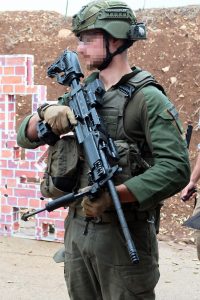
How does the Arbel allow such improvement? Although not all details were unveiled, EDR On-Line understood that the system takes in count the three fundamentals of marksmanship, which are stability, aiming and trigger pressure. Typically, the first round fired in full-auto mode with a machine gun is the most accurate, recoil and high rate of fire spreading the following around the target, which is the reason why good machine gunners tend to fire short bursts, four-five round at a time. The Arbel is capable to monitor the different factors, releasing the second round when the hit probability is at its peak, comparing the situation with the initial one, a good first shot ensuring therefore good repeatability thanks to the system developed by IWI. The analysis takes in count the shooter’s wobble during the initial aiming, then when he presses the trigger the system analyses the situation, allowing the release of the next round only when the situation is close to that of the initial round, ensuring maximum hit probability. This is obtained using MEMS (Micro Electro Mechanical Systems) motion sensors included in the lower part of the grip, which take in count lateral and vertical movements as well as rotation, the microprocessor carrying out the analysis, shots being released until the operator releases the trigger.
According to IWI, the pressure on the trigger is an indicator of the range at which the operator is firing; the shorter the distance, the quicker the reaction time, hence the stronger the pull, while when engaging a target at distance the pull is lighter, in order not to disturb accuracy. Another range indicator is how fast the operator is aiming, the faster the shorter the range. Sensing this, the Arbel can “understand” the range and tends to be itself more accurate, hence leaving more time between one round and the next one, lowering the firing rate. The technology used makes it shooter agnostic, each time the trigger is released the analysis process being stopped, to start again from scrap when the weapon is fired again.
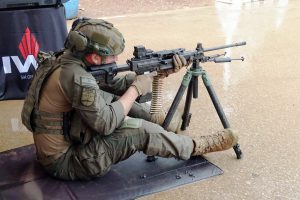
Compared to the typical machine gun rate of fire, which is usually around 1,000 rounds per minute, when shooting at close distance the Arbel can bring down the rate to around one third, let say 6 rounds per second rather than 15. This remains however higher than the rate of fire of a very well-trained operator shooting semi-auto, which seldom reaches 4 rounds per second, while ensuring better accuracy. At long range the Arbel can bring down the rate of fire at around 150 rounds per minute, which means 2.5 rounds per second. We definitely had the chance to feel the rate of fire difference when shooting at 85 metres distance first in auto mode and then in Arbel mode. In the end Arbel ensures the weapon delivers what IWI defines “the fastest controllable rate of fire,” which might also be defined as a full-auto controlled firing mode. The Arbel is wholly sight agnostic, as it does not employ an optic system to sense that the aiming is correct, but rather compares the initial situation with the following dynamics.
Arbel Arad
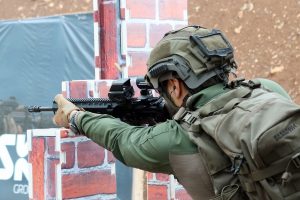
As anticipated IWI developed the Arbel in an AR15-type assault rifle configuration. Here the fire control group is still fitted inside the grip, the microprocessor with motion sensors and software being located on one side of the lower receiver, in front of the trigger group, while the battery is in the buttstock, its energy allowing for 50 hours continuous use. As in the Negev the battery is field replaceable and rechargeable.
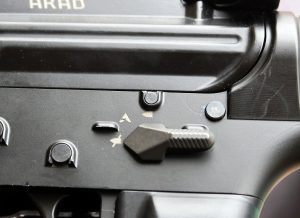
Electronics being either on the right or left side, this means that the selector is available only on the opposite side; on the Arbel Arad EDR On-Line could see at the range a fourth position had been added to the selector, which now has Safe/Arbel/Semi-auto/Auto positions, a 45° rotation being needed to switch between Safe and Arbel. The system behaves the same way as on the Negev, ensuring the best controlled automatic firing rate. Compared to the Negev solution the add-on mass is less than half, only 390 grams. According to IWI this is mainly due to the fact that dealing with an AR15-based assault rifle is much simpler than dealing with a machine gun in terms of mechanics, the battery remaining the same.
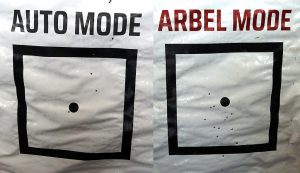
Tests made with a western army after three days of training have shown a 10% decrease in ammunition consumption and an increase from 23% to 73% of rounds on target. Going into details, tests were performed by four operators who shot 52 rounds without Arbel scoring 14 hits, while using the Arbel they shot 45 rounds scoring 33 hits. IWI also showed a firing session with a target at 12 metres distance and another at 50 metres; the window of opportunity for the first one was 1.5 seconds while for the second the soldier had twice the time to hit it. Using the AR15 without the Arbel the target at 50 metres was hit by a single shot, while using the system being unveiled by IWI three rounds hit it, something of paramount importance as the use of body armour requires more than one hit to neutralise an enemy soldier. At the shorter distance the number of rounds on target increased from six to 10.
Market perspectives
IWI considers the Arbel at TRL 7/8. In fact, EDR On-Line understood that some prototypes are currently being used by the IDF, lessons learned already being fed to IWI. Considering this, the Arbel status can be brought up to TRL 9, the system being de-facto combat proven.
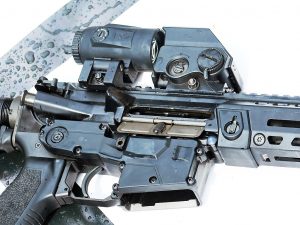
Beside IWI assault rifles, including the Tavor and the Arad also in 300 BLK, the Arbel has already been integrated on several AR15-based assault rifles, among them the original AR15, the M4, the HK416, the SIG516, and the FN US-made M4. As for LMGs, apart from the Negev for which the system is ready, IWI is starting to work on the FN Minimi. “IWI is ready to cooperate with other small arms manufacturers to integrate its Arbel into AR15-derived assault rifles and LMG platforms,” Ronen Hamudot, Corporate VP Marketing and Sales SK Group, said during the presentation. This is true either for production weapons as well as for upgrading existing platforms, the Arbel being all contained in the lower receiver; in most cases the upgrade is therefore a matter of removing a pin, replace the sub-assembly and reinsert the pin. EDR On-Line understood that some potential customers are requesting dedicated solutions, such as limited-rounds burst mode for the assault rifle, which might probably make sense considering the increased accuracy, and IWI retains this easily feasible, the system being computer controlled.
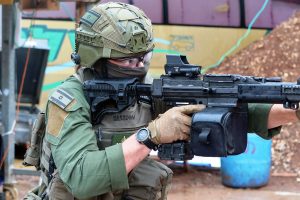
Looking at further developments, the company is considering other functionalities to be added to the system, no more details being unveiled, having a computer inside the weapon opens new horizons. Logistic issues, such as maintenance schemes based on the use of the weapon, should certainly be among those that can be implemented, these algorithms being already available on the market, while Artificial Intelligence might also disclose new solutions. All this with a look at SWAP-C, Size, Weight and Pore, and Cost, which remain key issues; evolution in batteries and further miniaturisation may allow to further reduce the system mass in the future.
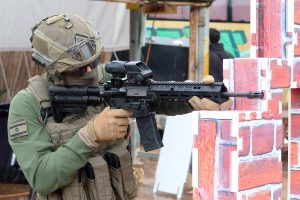
For the time being IWI looks with interest to the potential international market, and at the time of our visit the company was awaiting the Israeli MoD to issue the “tender for the purchase of tens of thousands of weapons from Israeli defence industries in the amount of tens of millions of NIS,” as stated by a press note released in February 2024 by Israeli authorities. The tender was expected to be issued days after our visit to IWI, and the company considers it will be based on an evolution of the Arad, as the IDF is considering a lighter and simpler platform.
Photos by P. Valpolini


